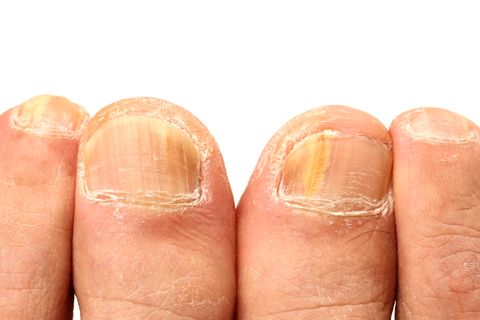Below: Causes | Symptoms | What you can do at home
There is an underlying reason why thick and gnarly toenails occur.
They can go unnoticed for some time before people seek treatment. If left untreated, they may become painful and harder to fix. If you’ve noticed that your toenails are becoming thicker, or yellow, it could be a fungal infection. If so, this needs treatment to prevent it from getting worse.
A brief biology lesson – the toenail is made up of three main areas: the nail bed or nail plate itself which is the part still attached to the skin; the edge of the nail that grows over the skin; the nail matrix which is where the nail actually grows from. Nails are made from a protein called keratin. As the nail grows from the base of the nail, cells lay down keratin in layers which eventually harden forming the nail.
We’ll help you treat thick or gnarly toenails and you can also help yourself at home, but first let’s have a look at why they happen.
Related articles:
The 10 most common foot problems we treat in our podiatry clinics
Athlete’s Foot: Causes, Symptoms and Treatment
What causes thick and gnarly toenails?
The most common reasons for thick or gnarly toenails are the following:
Fungal infections
Fungal infections such as tinea occur most commonly in the toenails. That’s because the warm and moist environment is ideal for fungus to grow and spread. The fungus distorts the growth of the nail affecting the nailbed. The signs are yellow or splitting toenails which lead to thickening.
Trauma
Trauma or injury to the nail can happen in three different ways:
- A heavy object dropped on the top of the nail bed will cause injury and trauma and the result is a thickened nail. This eventually grows out.
- Stubbing the end of your toenail causes trauma directed back into the nailbed, this will thicken the nail and will also eventually grow out.
- Dropping something heavy on the nail matrix however, where the nail grows from, can cause permanent nail thickening.
Ageing
As the body ages, the growth of toenails slows down as cell renewal slows, and less keratin is produced. The toenails can become brittle, prone to splitting, may also thicken and become discoloured.
Psoriasis
Psoriasis is a condition of the skin forming red, scaly patches which can be itchy and uncomfortable. Psoriasis can also extend to the toenails, causing ridges and thickening of the nail. The nailbed may also lift as a result of psoriasis.
Paronychia
Paronychia is a condition of the skin which lies along the nail itself. This skin can become infected with bacteria causing swelling, redness and you may even have a yellowy discharge from around the cuticle.
It’s essential to keep your feet clean and dry and use antiseptic lotions or barrier creams if necessary
Symptoms of thick toenails
Often toenails will start to thicken without being noticed. Good foot care will prevent this and should become a daily ritual. Every time you have a shower, wipe your feet and in between your toes, and check your nails for changes.
Here are changes in your toenails to check for:
- Toenails split or crack easily
- Toenails are brittle
- There is a bad odour from the nail
- The nails lift easily from the nail bed
- Dirt gets under the nail bed
- Pain or swelling anywhere around the nail
Self-help – how to prevent or minimise your nails thickening
- We recommend good foot care on a daily basis. Knowing what’s happening with your feet and toenails may seem obvious but paying proper attention every day will prevent future problems. Always wipe your feet well after a shower, and especially in between your toes to make sure they’re dry. Then check your nails for any changes.
- Don’t walk around in public places (e.g.public showers) with bare feet to avoid picking up any other bacteria.
- Keep your footwear clean and dry – regularly put them outside in the sunshine if possible.
- Keep your feet dry to prevent paronychia and other bacterial infections from growing in your toenails.
- Use antibacterial creams or lotions, or barrier creams if you work in an environment where you can’t avoid getting your feet wet.
- Wear shoes to protect your feet especially if your work is trade-related.
- Wear proper fitting shoes so that your toenails don’t rub against the shoe.
How we help at our podiatry clinic (Adelaide, Mount Barker and Stirling)
Phone our podiatry clinic and make an appointment to have your toenails assessed. We’ll determine the underlying cause for thickening toenails so that we can take immediate action toward a treatment plan. The sooner you get onto the problem, the better as nails left to thicken will become much harder to treat down the track.
Give one of our clinics a call on the numbers below and chat with our friend podiatry team to make an appointment.
Sander Podiatry Adelaide – 08 8379 1456 (Greenhill Podiatry)
